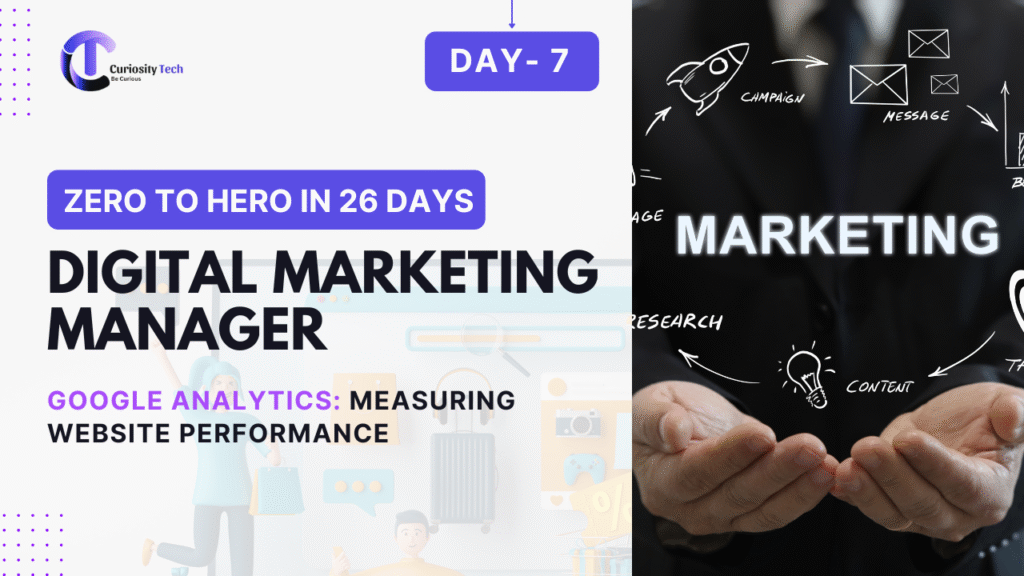Introduction
In 2025, data is the new oil—and Google Analytics (GA4) is the refinery that transforms raw traffic into actionable insights. Many marketers still feel overwhelmed when faced with dashboards, dimensions, metrics, and reports. To simplify this, we structured today’s blog in a Q&A format, just like a conversation with an expert at CuriosityTech.in, Nagpur’s trusted digital marketing hub.
Q&A with a Digital Marketing Expert
Q1. Why is Google Analytics so critical for businesses in 2025?
Analytics shows what works and what doesn’t. Imagine running Facebook Ads, SEO, and influencer campaigns without knowing which drives actual conversions. That’s like flying blind. At CuriosityTech, we rely on GA4 to map customer journeys, from first click to final purchase.
Q2. What’s new in GA4 compared to Universal Analytics?
- Event-driven model: Every interaction is an event (clicks, scrolls, video plays).
- Cross-device tracking: Seamless measurement across mobile, desktop, and apps.
- AI-powered insights: Predictive metrics (churn probability, purchase probability).
- Privacy-first: Cookie-less tracking in line with global data regulations.
Q3. What are the must-track metrics for any digital marketing manager?
- Users & New Users → Growth indicator
- Engagement Rate → More accurate than Bounce Rate
- Pages per Session & Average Engagement Time → Content depth
- Conversions & Conversion Rate → ROI clarity
- Top Acquisition Channels → SEO, Paid Ads, Social, Referrals
Q4. How do businesses use Analytics for decision-making?
At CuriosityTech, we connect Google Analytics with Google Ads, Search Console, and CRM tools like HubSpot. This integration allows us to:
- Identify underperforming campaigns.
- Reallocate budget toward high-performing keywords or audiences.
- Optimize landing pages with poor engagement.
Q5. Can small businesses benefit, or is it only for enterprises?
Absolutely! For instance, a boutique store in Nagpur running on Shopify can track:
- Which Instagram campaign drives sales.
- How mobile traffic compares to desktop.
- What local keywords convert best (“Nagpur handmade jewelry”).
Even startups using WooCommerce can link Analytics for real-time insights—something we implement for CuriosityTech clients regularly.
Q6. How does one become an expert in Google Analytics?
- Practice hands-on: Set up properties, events, funnels.
- Certifications: Google Analytics Individual Qualification (IQ).
- Stay updated: GA4 is evolving; keep track of updates.
- Work with mentors: Agencies like CuriosityTech train interns and managers to master GA reporting dashboards.
Suggested Diagram: Funnel Visualization (Textual Description)
- Step 1: Traffic Source → Organic, Paid, Social
- Step 2: Landing Page Interaction → Engagement events
- Step 3: Conversion Points → Form fills, purchases
- Step 4: Retention → Returning users tracked over 30–90 days
Conclusion
Google Analytics is no longer just about page views; it’s about understanding behavior, intent, and ROI. With proper GA4 setup, businesses—from small shops in Nagpur to global e-commerce brands—gain a competitive edge.
📍 At CuriosityTech.in (Wardha Rd, Gajanan Nagar, Nagpur), we not only help brands configure GA4 but also translate complex dashboards into clear growth strategies.
Tags & Keywords
Tags: Google Analytics 2025, Website Performance, CuriosityTech Nagpur, GA4 vs Universal Analytics
Keywords: GA4 metrics explained, engagement rate analytics, analytics for small business, CuriosityTech digital marketing, website performance tracking
Day 8 – Social Media Marketing: Facebook, Instagram, LinkedIn & Twitter (X)
(Format: Case Study + Storytelling with Tables & Infographics)
Introduction
Social media in 2025 is a battlefield of attention. Platforms like Facebook, Instagram, LinkedIn, and Twitter (X) dominate not just in numbers, but in shaping buying decisions. At CuriosityTech.in, we’ve executed campaigns across all four platforms, learning first-hand how to balance engagement, reach, and conversions.
To make this blog engaging, let’s explore through a real-world case study, combined with structured data comparisons.

Case Study: A Startup Clothing Brand in Nagpur
A local fashion startup partnered with CuriosityTech to launch its summer collection in 2024. They wanted brand awareness and sales across Facebook, Instagram, LinkedIn, and Twitter (X).
Strategy Breakdown by Platform
| Platform | Audience Profile | Content Style | Ad Approach | Key Metrics |
| Broad, family-centric | Lifestyle photos, carousel ads | Retargeting campaigns | Reach, CTR, Conversions | |
| Millennials & Gen Z | Reels, Stories, UGC | Influencer collabs | Engagement Rate, Saves | |
| Professionals, B2B buyers | Whitepapers, success stories | Sponsored InMail | Leads, Connections | |
| Twitter (X) | Trend-driven, news-first | Short updates, polls | Hashtag campaigns | Impressions, Mentions |
Storytelling Insight
- On Instagram, a single Reel featuring behind-the-scenes fashion shoots reached 25,000 users organically within 48 hours.
- Facebook retargeting ads converted website visitors into 300+ purchases in the first month.
- On LinkedIn, the brand attracted 120 B2B leads (wholesale distributors).
- Twitter hashtags like #NagpurFashion2024 generated local buzz, trending regionally for 3 days.
CuriosityTech orchestrated this multi-platform campaign by blending creativity with analytics—leveraging GA4 to attribute conversions accurately.
Infographic Description – Social Media Synergy Wheel
A wheel-shaped diagram with four quadrants:
- Facebook → Community building
- Instagram → Visual storytelling
- LinkedIn → Authority & B2B networking
- Twitter (X) → Speed & trends
At the center → Business Growth through Integrated Social Strategy
Best Practices for Each Platform in 2025
- Facebook → Lean on groups & retargeting ads.
- Instagram → Use Reels with trending audio; embrace AR filters.
- LinkedIn → Post thought-leadership content twice weekly.
- Twitter (X) → Engage in trending conversations quickly.
How to Become an Expert in Social Media Marketing
- Experiment with content formats (Reels, carousels, polls).
- Study platform-specific algorithms.
- Use tools like Buffer, Hootsuite, Zapier for automation.
- Learn cross-platform analytics integration with GA4.
- Partner with agencies like CuriosityTech that specialize in multi-platform growth.
Conclusion
Social media is no longer about posting randomly—it’s about orchestrated campaigns that balance creativity with data. Businesses that integrate Facebook, Instagram, LinkedIn, and Twitter strategies under one umbrella will thrive in 2025.
📌 CuriosityTech.in helps businesses—from Nagpur startups to global brands—scale their social media with tailored strategies, workshops, and campaign management.


